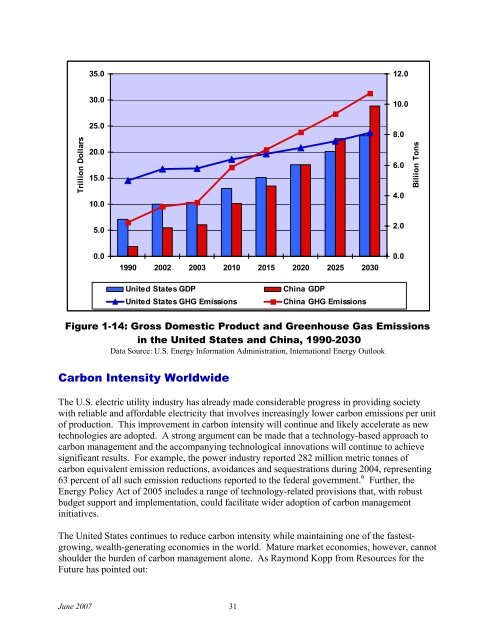Technologies to Reduce or Capture and Store Carbon Dioxide Emissions
TECHNOLOgIEs to Reduce or Capture and store Carbon Dioxide ...
TECHNOLOgIEs to Reduce or Capture and store Carbon Dioxide ...
You also want an ePaper? Increase the reach of your titles
YUMPU automatically turns print PDFs into web optimized ePapers that Google loves.
35.0<br />
12.0<br />
30.0<br />
10.0<br />
Trillion Dollars<br />
25.0<br />
20.0<br />
15.0<br />
10.0<br />
5.0<br />
8.0<br />
6.0<br />
4.0<br />
2.0<br />
Biliion Tons<br />
0.0<br />
1990 2002 2003 2010 2015 2020 2025 2030<br />
0.0<br />
United States GDP<br />
United States GHG <strong>Emissions</strong><br />
China GDP<br />
China GHG <strong>Emissions</strong><br />
Figure 1-14: Gross Domestic Product <strong>and</strong> Greenhouse Gas <strong>Emissions</strong><br />
in the United States <strong>and</strong> China, 1990-2030<br />
Data Source: U.S. Energy Inf<strong>or</strong>mation Administration, International Energy Outlook<br />
<strong>Carbon</strong> Intensity W<strong>or</strong>ldwide<br />
The U.S. electric utility industry has already made considerable progress in providing society<br />
with reliable <strong>and</strong> aff<strong>or</strong>dable electricity that involves increasingly lower carbon emissions per unit<br />
of production. This improvement in carbon intensity will continue <strong>and</strong> likely accelerate as new<br />
technologies are adopted. A strong argument can be made that a technology-based approach <strong>to</strong><br />
carbon management <strong>and</strong> the accompanying technological innovations will continue <strong>to</strong> achieve<br />
significant results. F<strong>or</strong> example, the power industry rep<strong>or</strong>ted 282 million metric <strong>to</strong>nnes of<br />
carbon equivalent emission reductions, avoidances <strong>and</strong> sequestrations during 2004, representing<br />
63 percent of all such emission reductions rep<strong>or</strong>ted <strong>to</strong> the federal government. 6 Further, the<br />
Energy Policy Act of 2005 includes a range of technology-related provisions that, with robust<br />
budget supp<strong>or</strong>t <strong>and</strong> implementation, could facilitate wider adoption of carbon management<br />
initiatives.<br />
The United States continues <strong>to</strong> reduce carbon intensity while maintaining one of the fastestgrowing,<br />
wealth-generating economies in the w<strong>or</strong>ld. Mature market economies, however, cannot<br />
shoulder the burden of carbon management alone. As Raymond Kopp from Resources f<strong>or</strong> the<br />
Future has pointed out:<br />
June 2007 31


